A New Empirical Model of Weighted Mean Temperature Combining ERA5 Reanalysis Data, Radiosonde Data, and TanDEM-X 90m Products over China
Abstract
1. Introduction
2. Determination of Weighted Mean Temperature and Surface Elevation
2.1. Tm Derived from Radiosonde and Reanalysis Data
2.2. Surface Elevation from TanDEM-X 90m DEM Products
3. Model Establishment of Weighted Mean Temperature
3.1. Height Correction for Tm
3.2. Time Series Modeling Using the Fourier Series
- Tms values smaller than 210 K and higher than 303 K are removed in the threshold check, while β values smaller than −10 K/km and higher than 0 K/km are removed.
- Tms values and β values that differ from their mean value by more than 3 times the standard deviation are removed.
3.3. Bias Correction for the Tm Lapse Rate
4. Model Validation
4.1. Accuracy Analysis Using ERA5 Tm Data
4.2. Accuracy Analysis Using Radiosonde Tm Data
4.3. Impact of Tm Estimations on the GNSS PWV Derivation
5. Conclusions
Author Contributions
Funding
Data Availability Statement
Acknowledgments
Conflicts of Interest
References
- Allan, R.P. The Role of Water Vapour in Earth’s Energy Flows. Surv. Geophys. 2012, 33, 557–564. [Google Scholar] [CrossRef]
- Shi, C.; Zhang, W.X.; Cao, Y.C.; Lou, Y.D.; Liang, H.; Fan, L.; Satirapod, C.; Trakolkul, C. Atmospheric Water Vapor Climatological Characteristics over Indo-China Region Based on Beidou/GNSS and Relationships with Precipitation. Acta Geod. Et Cartogr. Sin. 2020, 49, 1112–1119. [Google Scholar]
- Bevis, M.; Businger, S.; Herring, T.A.; Rocken, C.; Anthes, R.A.; Ware, R.H. GPS Meteorology: Remote Sensing of Atmospheric Water Vapor Using the Global Positioning System. J. Geophys. Res. Atmos. 1992, 97, 15787–15801. [Google Scholar] [CrossRef]
- Manandhar, S.; Lee, Y.H.; Meng, Y.S.; Ong, J.T. A Simplified Model for the Retrieval of Precipitable Water Vapor from GPS Signal. IEEE Trans. Geosci. Remote Sens. 2017, 55, 6245–6253. [Google Scholar] [CrossRef]
- Li, X.X.; Dick, G.; Lu, C.X.; Ge, M.R.; Nilsson, T.; Ning, T.; Wickert, J.; Schuh, H. Multi-GNSS Meteorology: Real-Time Retrieving of Atmospheric Water Vapor from Beidou, Galileo, GLONASS, and GPS Observations. IEEE Trans. Geosci. Remote Sens. 2015, 53, 6385–6393. [Google Scholar] [CrossRef]
- Yang, F.; Guo, J.M.; Meng, X.L.; Li, J.; Li, Z.C.; Tang, W. GGTm-Ts: A Global Grid Model of Weighted Mean Temperature (Tm) Based on Surface Temperature (Ts) with Two Modes. Adv. Space Res. 2023, 71, 1510–1524. [Google Scholar] [CrossRef]
- Wang, J.H.; Zhang, L.Y.; Dai, A.G.; Van Hove, T.; Van Baelen, J. A near-Global, 2-Hourly Data Set of Atmospheric Precipitable Water from Ground-Based GPS Measurements. J. Geophys. Res. Atmos. 2007, 112. [Google Scholar] [CrossRef]
- Vey, S.; Dietrich, R.; Ruelke, A.; Fritsche, M.; Steigenberger, P.; Rothacher, M. Validation of Precipitable Water Vapor within the NCEP/DOE Reanalysis Using Global GPS Observations from One Decade. J. Clim. 2010, 23, 1675–1695. [Google Scholar] [CrossRef]
- Guo, J.Y.; Hou, R.; Zhou, M.S.; Jin, X.; Li, C.M.; Liu, X.; Gao, H. Monitoring 2019 Forest Fires in Southeastern Australia with GNSS Technique. Remote Sens. 2021, 13, 386. [Google Scholar] [CrossRef]
- Zhao, Q.Z.; Liu, Y.; Ma, X.W.; Yao, W.Q.; Yao, Y.B.; Li, X. An Improved Rainfall Forecasting Model Based on GNSS Observations. IEEE Trans. Geosci. Remote Sens. 2020, 58, 4891–4900. [Google Scholar] [CrossRef]
- Bevis, M.; Businger, S.; Chiswell, S.; Herring, T.A.; Anthes, R.A.; Rocken, C.; Ware, R.H. GPS Meteorology—Mapping Zenith Wet Delays onto Precipitable Water. J. Appl. Meteorol. 1994, 33, 379–386. [Google Scholar] [CrossRef]
- Wang, X.M.; Zhang, K.F.; Wu, S.Q.; Fan, S.J.; Cheng, Y.Y. Water Vapor-Weighted Mean Temperature and Its Impact on the Determination of Precipitable Water Vapor and Its Linear Trend. J. Geophys. Res. Atmos. 2016, 121, 833–852. [Google Scholar] [CrossRef]
- Davis, J.L.; Herring, T.A.; Shapiro, I.I.; Rogers, A.E.E.; Elgered, G. Geodesy by Radio Interferometry—Effects of Atmospheric Modeling Errors on Estimates of Baseline Length. Radio Sci. 1985, 20, 1593–1607. [Google Scholar] [CrossRef]
- Yao, Y.B.; Zhu, S.; Yue, S.Q. A Globally Applicable, Season-Specific Model for Estimating the Weighted Mean Temperature of the Atmosphere. J. Geod. 2012, 86, 1125–1135. [Google Scholar] [CrossRef]
- Yao, Y.B.; Xu, C.Q.; Zhang, B.; Cao, N. GTm-III: A New Global Empirical Model for Mapping Zenith Wet Delays onto Precipitable Water Vapour. Geophys. J. Int. 2014, 197, 202–212. [Google Scholar] [CrossRef]
- Yang, F.; Guo, J.M.; Meng, X.L.; Shi, J.B.; Zhang, D.; Zhao, Y.Z. An Improved Weighted Mean Temperature (Tm) Model Based on GPT2w with Tm Lapse Rate. GPS Solut. 2020, 24, 46. [Google Scholar] [CrossRef]
- Huang, L.K.; Jiang, W.P.; Liu, L.L.; Chen, H.; Ye, S.R. A New Global Grid Model for the Determination of Atmospheric Weighted Mean Temperature in GPS Precipitable Water Vapor. J. Geod. 2019, 93, 159–176. [Google Scholar] [CrossRef]
- Lan, Z.; Zhang, B.; Geng, Y. Establishment and Analysis of Global Gridded Tm−Ts Relationship Model. Geod. Geodyn. 2016, 7, 101–107. [Google Scholar] [CrossRef]
- Ding, M.H. A Second Generation of the Neural Network Model for Predicting Weighted Mean Temperature. GPS Solut. 2020, 24, 61. [Google Scholar] [CrossRef]
- Liu, W.; Zhang, L.L.; Xiong, S.; Huang, L.K.; Xie, S.F.; Liu, L.L. Investigating the ERA5-Based Pwv Products and Identifying the Monsoon Active and Break Spells with Dense GNSS Sites in Guangxi, China. Remote Sens. 2023, 15, 4710. [Google Scholar] [CrossRef]
- Yao, Y.B.; Zhang, B.; Yue, S.Q.; Xu, C.Q.; Peng, W.F. Global Empirical Model for Mapping Zenith Wet Delays onto Precipitable Water. J. Geod. 2013, 87, 439–448. [Google Scholar] [CrossRef]
- Boehm, J.; Heinkelmann, R.; Schuh, H. Short Note: A Global Model of Pressure and Temperature for Geodetic Applications. J. Geod. 2007, 81, 679–683. [Google Scholar] [CrossRef]
- Li, Q.Z.; Yuan, L.G.; Chen, P.; Jiang, Z.S. Global Grid-Based Tm Model with Vertical Adjustment for GNSS Precipitable Water Retrieval. GPS Solut. 2020, 24, 73. [Google Scholar] [CrossRef]
- Leandro, R.F.; Langley, R.B.; Santos, M.C. UNB3m_Pack: A Neutral Atmosphere Delay Package for Radiometric Space Techniques. GPS Solut. 2008, 12, 65–70. [Google Scholar] [CrossRef]
- Bohm, J.; Moller, G.; Schindelegger, M.; Pain, G.; Weber, R. Development of an Improved Empirical Model for Slant Delays in the Troposphere (GPT2w). GPS Solut. 2015, 19, 433–441. [Google Scholar] [CrossRef]
- Landskron, D.; Bohm, J. VMF3/GPT3: Refined Discrete and Empirical Troposphere Mapping Functions. J. Geod. 2018, 92, 349–360. [Google Scholar] [CrossRef]
- Mateus, P.; Catalao, J.; Mendes, V.B.; Nico, G. An ERA5-Based Hourly Global Pressure and Temperature (HGPT) Model. Remote Sens. 2020, 12, 1098. [Google Scholar] [CrossRef]
- Huang, L.K.; Liu, L.L.; Chen, H.; Jiang, W.P. An Improved Atmospheric Weighted Mean Temperature Model and Its Impact on GNSS Precipitable Water Vapor Estimates for China. GPS Solut. 2019, 23, 51. [Google Scholar] [CrossRef]
- Zhang, H.X.; Yuan, Y.B.; Li, W.; Ou, J.K.; Li, Y.; Zhang, B.C. GPS PPP-Derived Precipitable Water Vapor Retrieval Based on Tm/Ps from Multiple Sources of Meteorological Data Sets in China. J. Geophys. Res. Atmos. 2017, 122, 4165–4183. [Google Scholar] [CrossRef]
- Yao, Y.B.; Sun, Z.Y.; Xu, C.Q.; Xu, X.Y.; Kong, J. Extending a Model for Water Vapor Sounding by Ground-Based GNSS in the Vertical Direction. J. Atmos. Sol. Terr. Phys. 2018, 179, 358–366. [Google Scholar] [CrossRef]
- Sun, Z.Y.; Zhang, B.; Yao, Y.B. A Global Model for Estimating Tropospheric Delay and Weighted Mean Temperature Developed with Atmospheric Reanalysis Data from 1979 to 2017. Remote Sens. 2019, 11, 1893. [Google Scholar] [CrossRef]
- Zhang, W.; Zhang, H.; Liang, H.; Lou, Y.; Cai, Y.; Cao, Y.; Zhou, Y.; Liu, W. On the Suitability of ERA5 in Hourly GPS Precipitable Water Vapor Retrieval over China. J. Geod. 2019, 93, 1897–1909. [Google Scholar] [CrossRef]
- ECMWF. Ifs Documentation Cy47r3—Part I: Observations. In Ifs Documentation Cy47r3; ECMWF: Reading, UK, 2021. [Google Scholar]
- Hoffmann, L.; Guenther, G.; Li, D.; Stein, O.; Wu, X.; Griessbach, S.; Heng, Y.; Konopka, P.; Mueller, R.; Vogel, B.; et al. From ERA-Interim to ERA5: The Considerable Impact of ECMWF’s Next-Generation Reanalysis on Lagrangian Transport Simulations. Atmos. Chem. Phys. 2019, 19, 3097–3124. [Google Scholar] [CrossRef]
- Albergel, C.; Dutra, E.; Munier, S.; Calvet, J.C.; Munoz-Sabater, J.; Rosnay, P.D.; Balsamo, G. ERA-5 and ERA-Interim Driven ISBA Land Surface Model Simulations: Which One Performs Better? Hydrol. Earth Syst. Sci. 2018, 22, 3515–3532. [Google Scholar] [CrossRef]
- Wessel, B. TanDEM-X Ground Segment—DEM Products Specification Document; Deutsches Zentrum für Luft—und Raumfahrt (DLR): Porz, Germany, 2018. [Google Scholar]
- Zink, M.; Bachmann, M.; Brautigam, B.; Fritz, T.; Hajnsek, I.; Moreira, A.; Wessel, B.; Krieger, G. TanDEM-X: The New Global DEM Takes Shape. IEEE Geosci. Remote Sens. Mag. 2014, 2, 8–23. [Google Scholar] [CrossRef]
- Rizzoli, P.; Martone, M.; Gonzalez, C.; Wecklich, C.; Tridon, D.B.; Bräutigam, B.; Bachmann, M.; Schulze, D.; Fritz, T.; Huber, M. Generation and Performance Assessment of the Global TanDEM-X Digital Elevation Model. ISPRS J. Photogramm. Remote Sens. 2017, 132, 119–139. [Google Scholar] [CrossRef]
- Hawker, L.; Neal, J.; Bates, P. Accuracy Assessment of the TanDEM-X 90 Digital Elevation Model for Selected Floodplain Sites. Remote Sens. Environ. 2019, 232, 111319. [Google Scholar] [CrossRef]
- Ke, L.H.; Song, C.Q.; Yong, B.; Lei, Y.B.; Ding, X.L. Which Heterogeneous Glacier Melting Patterns Can Be Robustly Observed from Space? A Multi-Scale Assessment in Southeastern Tibetan Plateau. Remote Sens. Environ. 2020, 242, 111777. [Google Scholar] [CrossRef]
- Wu, Q.H.; Song, C.Q.; Liu, K.; Ke, L.H. Integration of TanDEM-X and SRTM DEMs and Spectral Imagery to Improve the Large-Scale Detection of Opencast Mining Areas. Remote Sens. 2020, 12, 1451. [Google Scholar] [CrossRef]
- Vanthof, V.; Kelly, R. Water Storage Estimation in Ungauged Small Reservoirs with the TanDEM-X DEM and Multi-Source Satellite Observations. Remote Sens. Environ. 2019, 235, 111437. [Google Scholar] [CrossRef]
- He, C.Y.; Wu, S.Q.; Wang, X.M.; Hu, A.D.; Wang, Q.X.; Zhang, K.F. A New Voxel-Based Model for the Determination of Atmospheric Weighted Mean Temperature in GPS Atmospheric Sounding. Atmos. Meas. Tech. 2017, 10, 2045–2060. [Google Scholar] [CrossRef]
- Ge, S.J. GPS Radio Occultation and the Role of Atmospheric Pressure on Spaceborne Gravity Estimation over Antarctica; The Ohio State University: Columbus, OH, USA, 2006. [Google Scholar]
- Huang, L.K.; Zhu, G.; Liu, L.L.; Chen, H.; Jiang, W.P. A Global Grid Model for the Correction of the Vertical Zenith Total Delay Based on a Sliding Window Algorithm. GPS Solut. 2021, 25, 98. [Google Scholar] [CrossRef]
- Ding, M.H.; Hu, W.S. A Further Contribution to the Seasonal Variation of Weighted Mean Temperature. Adv. Space Res. 2017, 60, 2414–2422. [Google Scholar] [CrossRef]
- Sun, Z.Y.; Zhang, B.; Yao, Y.B. An ERA5-Based Model for Estimating Tropospheric Delay and Weighted Mean Temperature over China with Improved Spatiotemporal Resolutions. Earth Space Sci. 2019, 6, 1926–1941. [Google Scholar] [CrossRef]
- Sun, P.; Wu, S.Q.; Zhang, K.F.; Wan, M.F.; Wang, R. A New Global Grid-Based Weighted Mean Temperature Model Considering Vertical Nonlinear Variation. Atmos. Meas. Tech. 2021, 14, 2529–2542. [Google Scholar] [CrossRef]
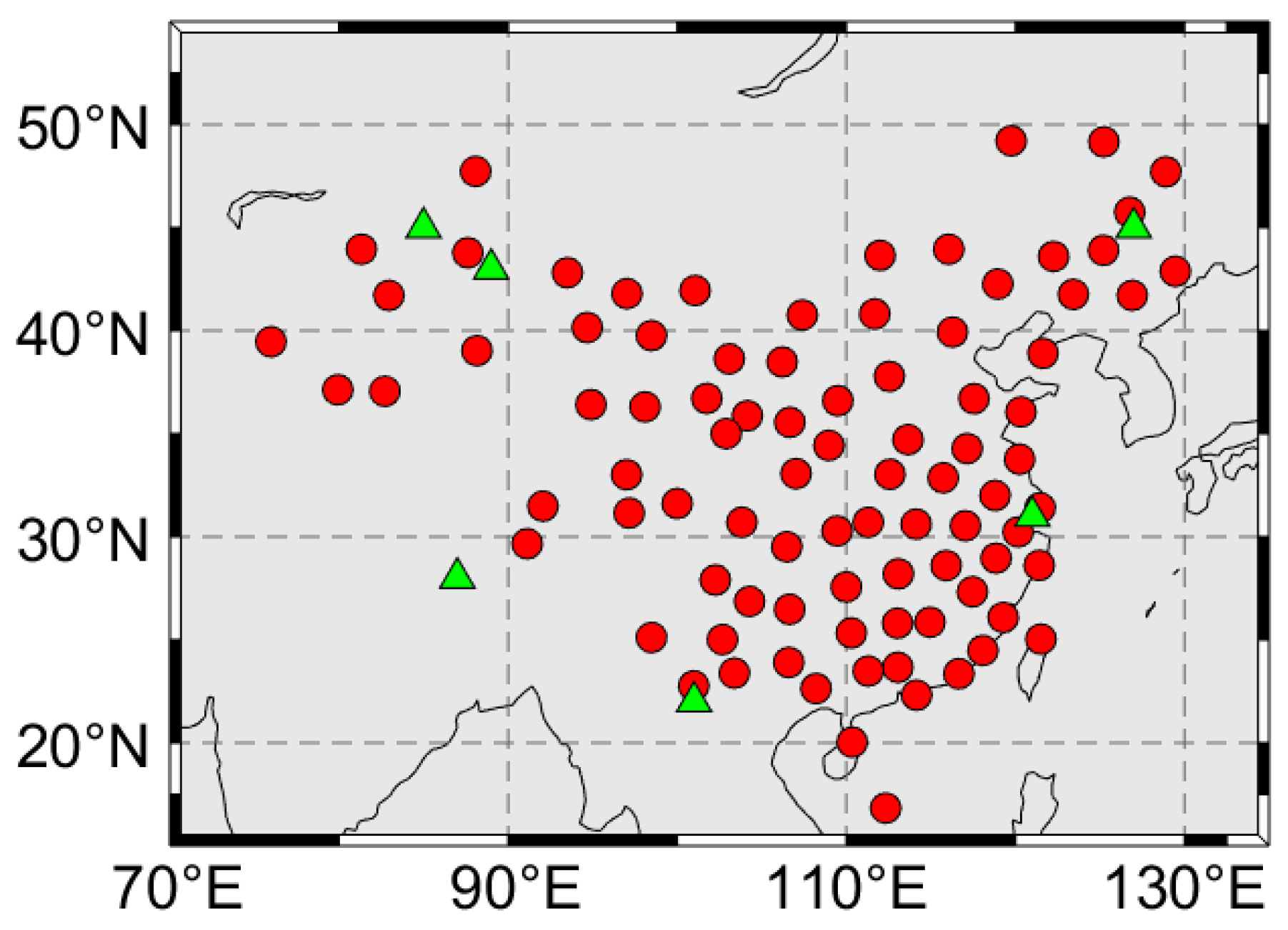


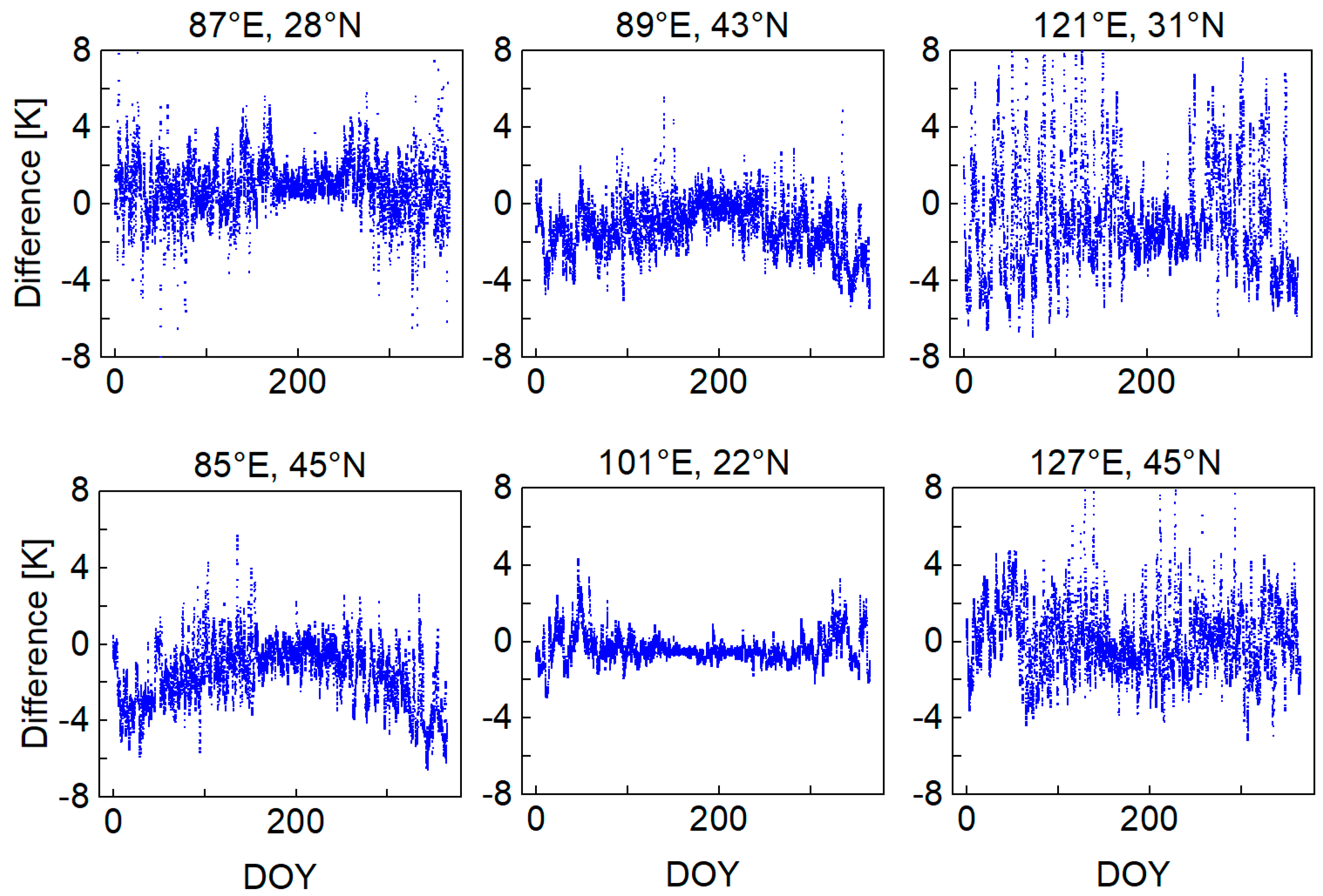

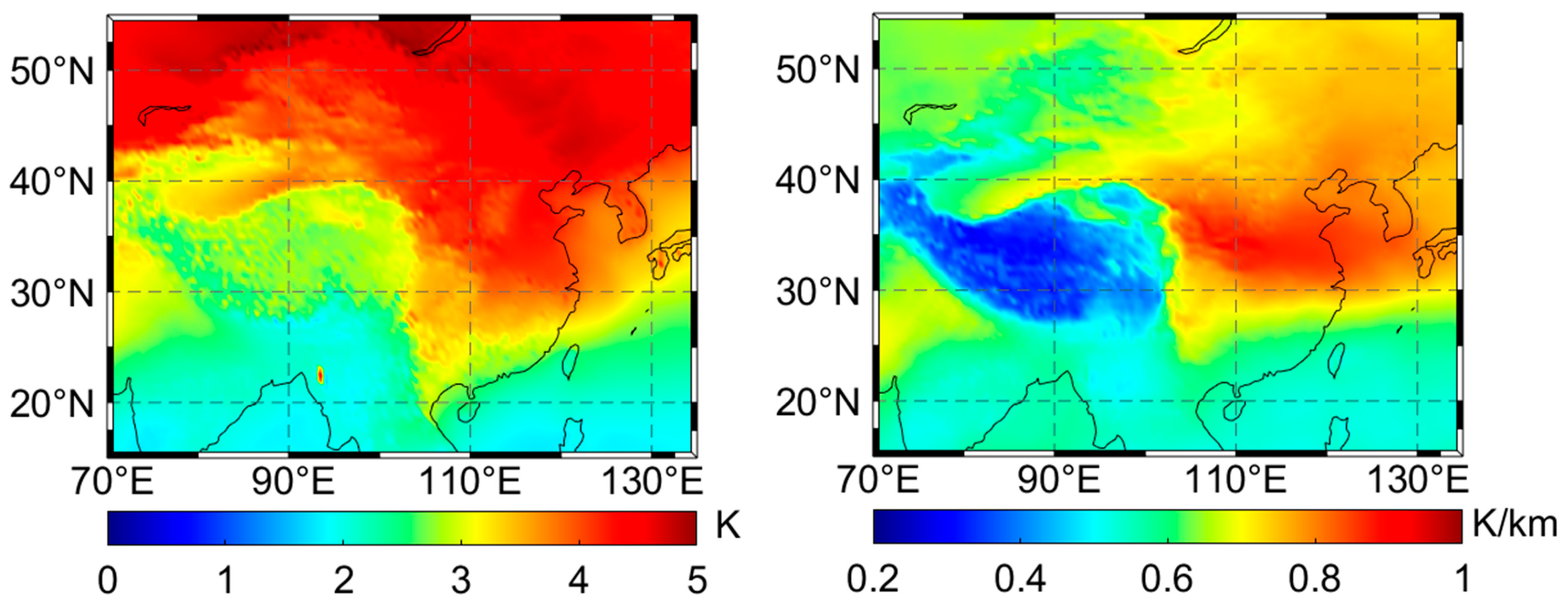
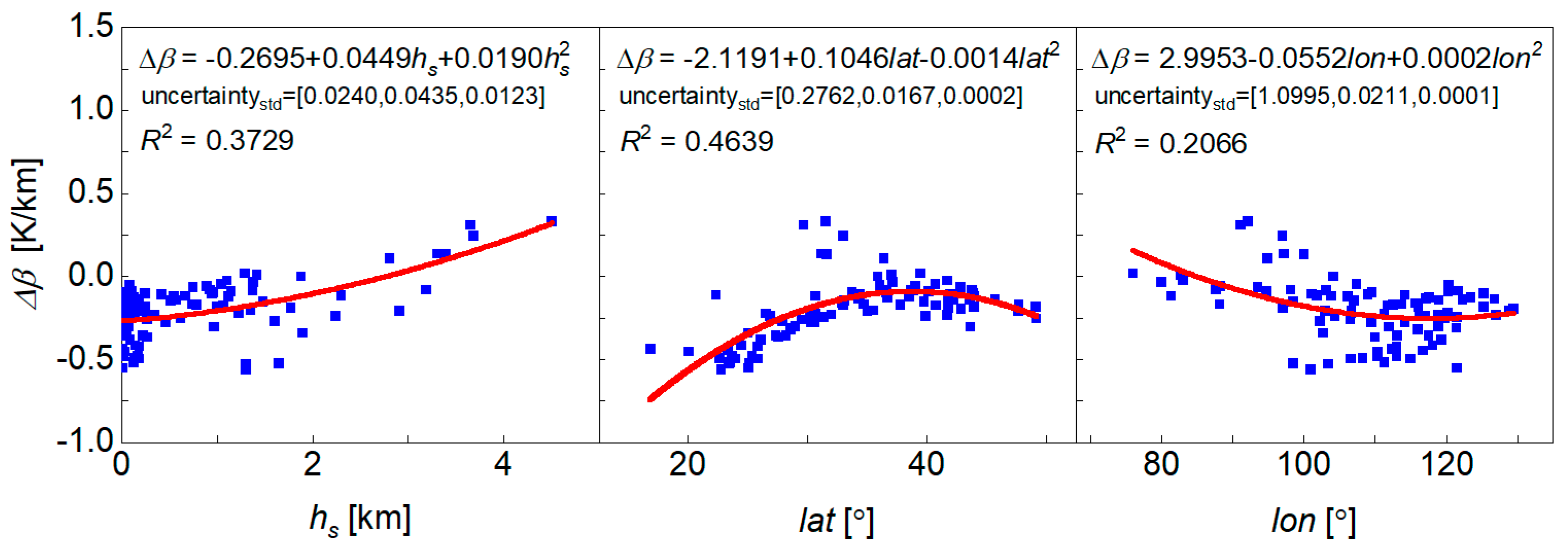
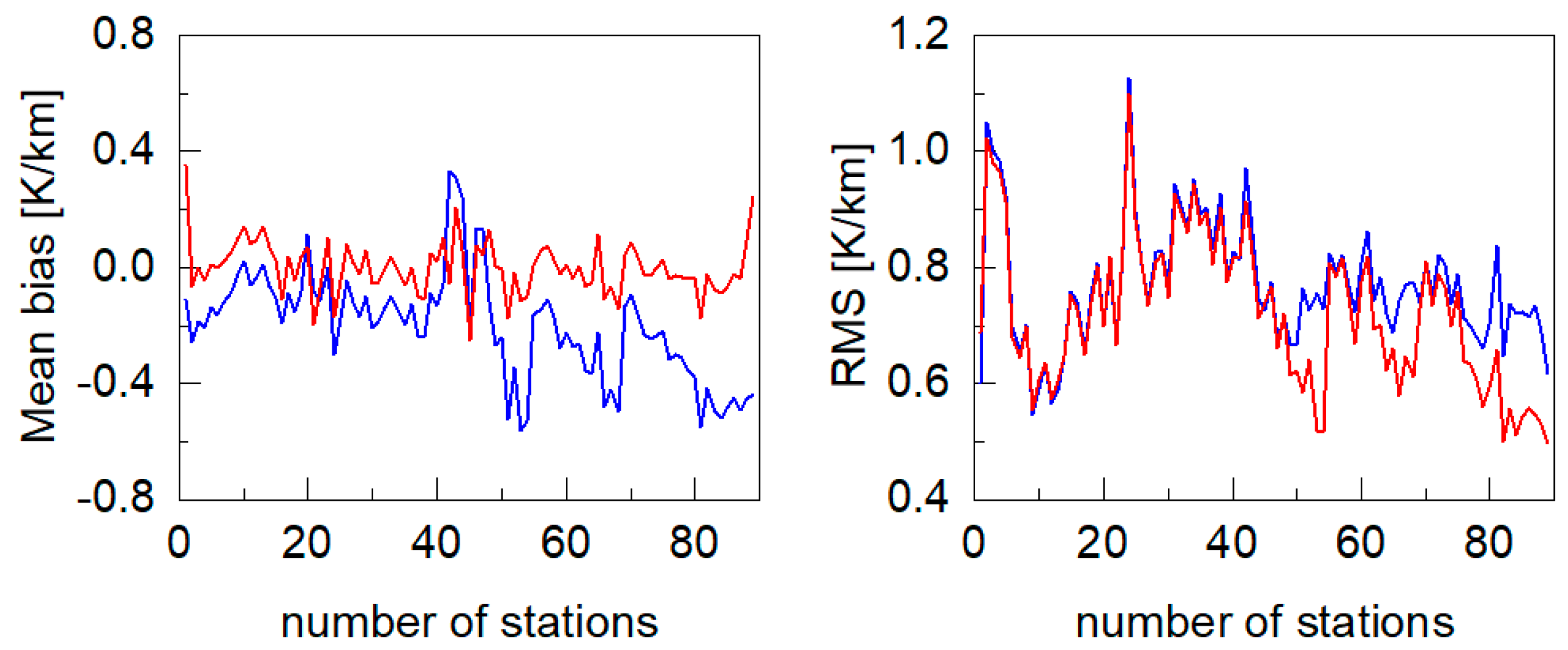
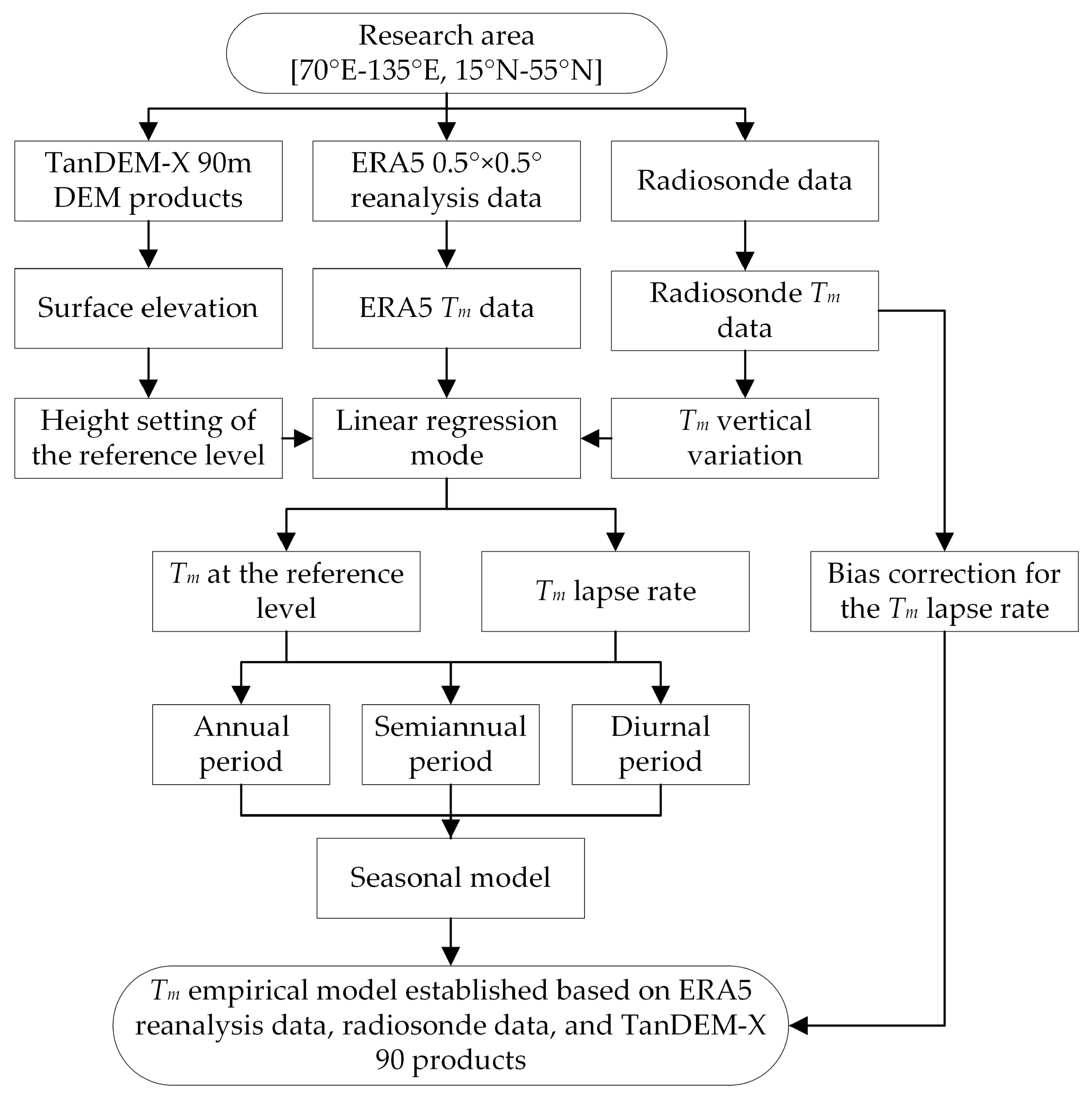
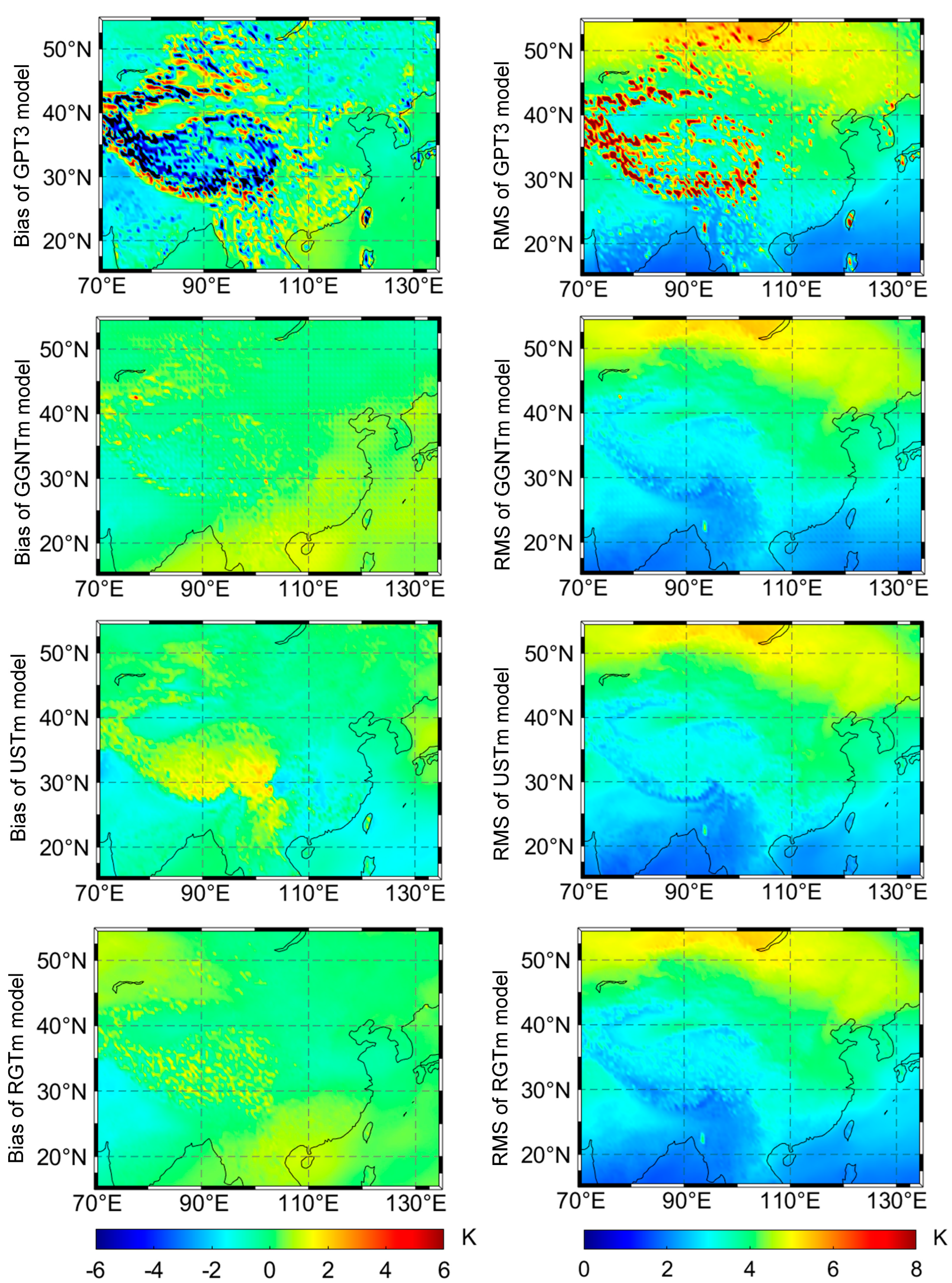


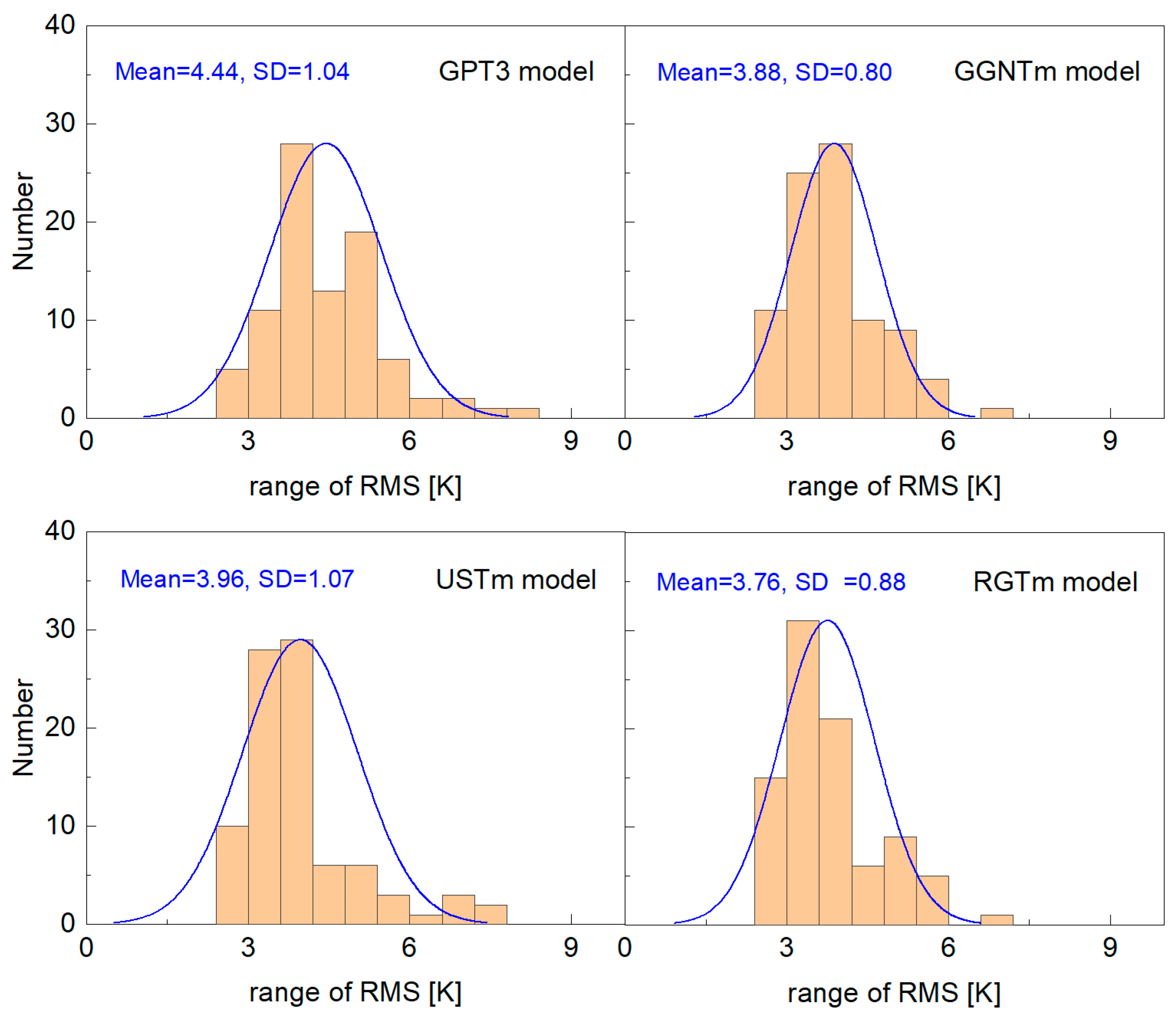
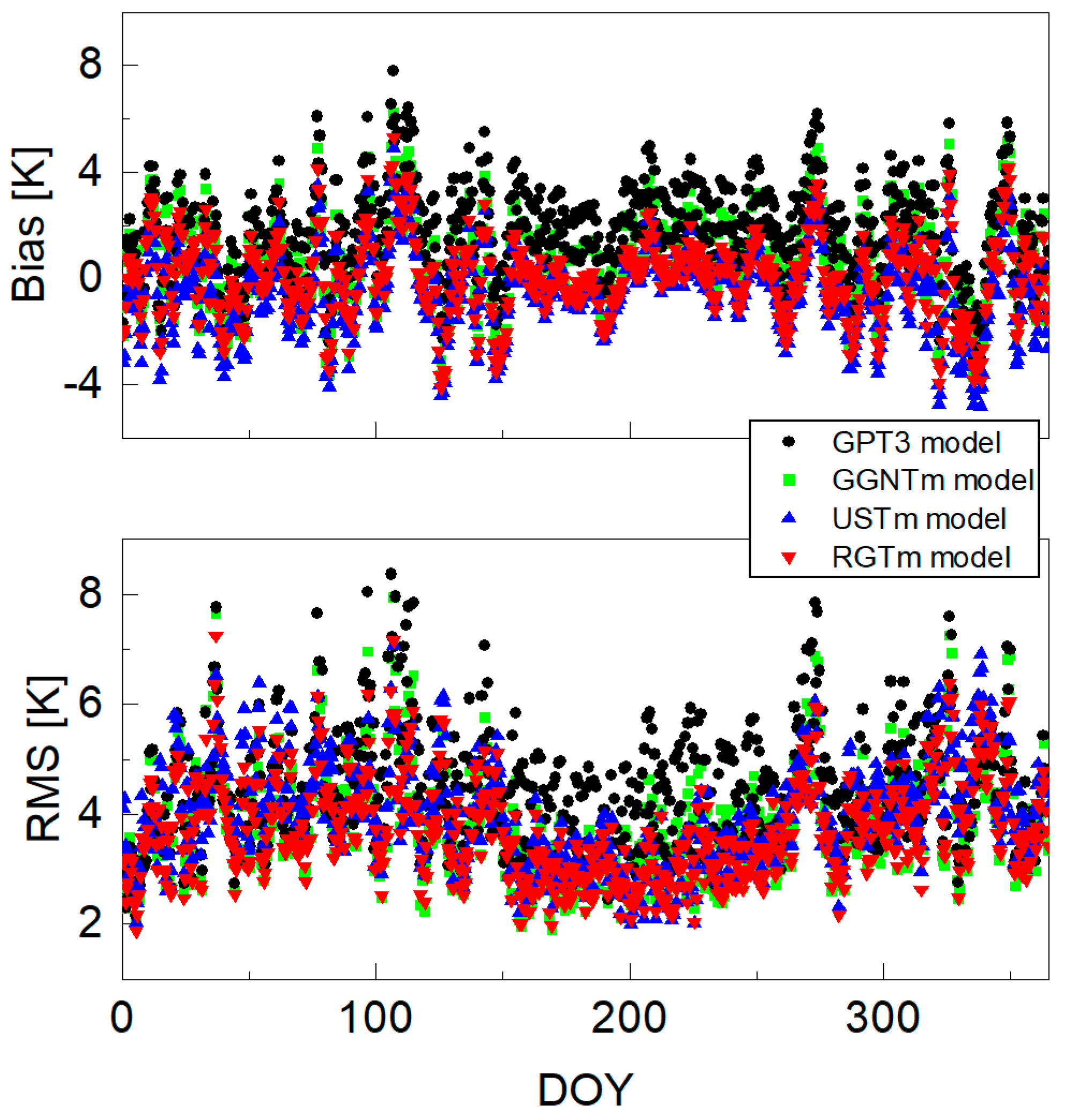
| Model | Bias (K) | RMS (K) | ||||
|---|---|---|---|---|---|---|
| Max | Min | Mean | Max | Min | Mean | |
| GPT3 model | 13.11 | −21.45 | −0.66 | 21.87 | 1.66 | 3.85 |
| GGNTm model | 5.31 | −1.90 | 0.17 | 6.17 | 1.77 | 3.42 |
| USTm model | 2.50 | −2.31 | −0.29 | 5.56 | 1.68 | 3.46 |
| RGTm model | 1.65 | −1.61 | 0.07 | 5.56 | 1.66 | 3.38 |
| Model | Bias (K) | RMS (K) | ||||
|---|---|---|---|---|---|---|
| Max | Min | Mean | Max | Min | Mean | |
| GPT3 model | 7.41 | −3.27 | 1.76 | 8.15 | 2.43 | 4.44 |
| GGNTm model | 3.08 | −3.81 | 0.62 | 6.68 | 2.54 | 3.88 |
| USTm model | 2.99 | −6.32 | −0.50 | 7.62 | 2.48 | 3.96 |
| RGTm model | 3.25 | −4.20 | 0.06 | 6.73 | 2.42 | 3.76 |
Disclaimer/Publisher’s Note: The statements, opinions and data contained in all publications are solely those of the individual author(s) and contributor(s) and not of MDPI and/or the editor(s). MDPI and/or the editor(s) disclaim responsibility for any injury to people or property resulting from any ideas, methods, instructions or products referred to in the content. |
© 2024 by the authors. Licensee MDPI, Basel, Switzerland. This article is an open access article distributed under the terms and conditions of the Creative Commons Attribution (CC BY) license (https://creativecommons.org/licenses/by/4.0/).
Share and Cite
Zhang, J.; Yang, L.; Wang, J.; Wang, Y.; Liu, X. A New Empirical Model of Weighted Mean Temperature Combining ERA5 Reanalysis Data, Radiosonde Data, and TanDEM-X 90m Products over China. Remote Sens. 2024, 16, 855. https://doi.org/10.3390/rs16050855
Zhang J, Yang L, Wang J, Wang Y, Liu X. A New Empirical Model of Weighted Mean Temperature Combining ERA5 Reanalysis Data, Radiosonde Data, and TanDEM-X 90m Products over China. Remote Sensing. 2024; 16(5):855. https://doi.org/10.3390/rs16050855
Chicago/Turabian StyleZhang, Jingkui, Liu Yang, Jian Wang, Yifan Wang, and Xitian Liu. 2024. "A New Empirical Model of Weighted Mean Temperature Combining ERA5 Reanalysis Data, Radiosonde Data, and TanDEM-X 90m Products over China" Remote Sensing 16, no. 5: 855. https://doi.org/10.3390/rs16050855
APA StyleZhang, J., Yang, L., Wang, J., Wang, Y., & Liu, X. (2024). A New Empirical Model of Weighted Mean Temperature Combining ERA5 Reanalysis Data, Radiosonde Data, and TanDEM-X 90m Products over China. Remote Sensing, 16(5), 855. https://doi.org/10.3390/rs16050855






